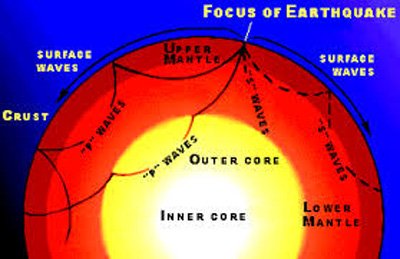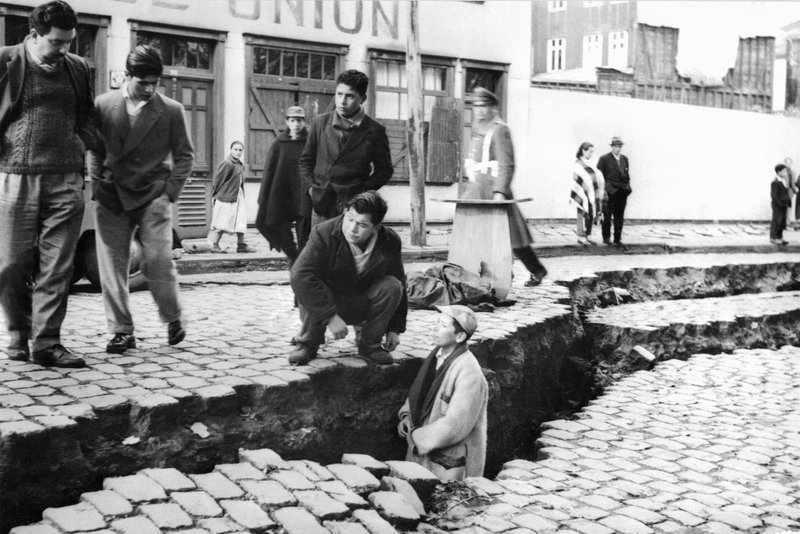نیارش گستر ایران
ساختن دست یافتنی است!نیارش گستر ایران
ساختن دست یافتنی است!عمق زلزله - Depth of an Earthquake
جایی که تکان سنگ ها رخ می دهد، هر چه به سطح زمین نزدیک تر باشد، عمق زلزله کمتر و خطر آن بیشتر است. آنچه درباره قدرت تخریب زلزله گفتیم، مربوط به زلزله هایی هستند که نزدیک سطح زمین رخ می دهند. بنابر این ممکن است زلزله ای به قدرت 7 ریشتر در عمق 300 کیلومتری زمین رخ دهد و خسارت بار نباشد ولی زلزله 5.5 ریشتری در عمق 10 کیلومتری، مرگبار باشد.
عمق زلزله را به سه بخش تقسیم می کنند:
زلزله های عمیق:
بیش از 300 کیلومتر از سطح زمین فاصله دارند.
زلزله های متوسط:
بین 60 تا 300 کیلومتر
زلزله های کم عمق :
کمتر از 60 کیلومتر
علاوه بر عمق زلزله، مسائلی مانند جنس خاک، دوری و نزدیکی به گسل، شیب سطح و ... در تعیین قدرت تخریب یک زمین لرزه، موثرند.

زمینلرزه ۱۹۶۰ والدیویا، شیلی- 1960 Valdivia earthquake

زمینلرزهٔ ۱۹۶۰ والدیویا یا زمینلرزهٔ عظیم شیلی در تاریخ ۲۲ مه ۱۹۶۰ میلادی، برابر با ۱ خرداد ۱۳۳۹، ساعت ۱۹:۱۱:۱۷ به زمان یوتیسی در شیلی، منطقه والدیویا رخ داد. این زمینلرزه قدرتمندترین زمینلرزهٔ ثبت شده در تاریخ است. ژرفای این زلزله ۳۵ کیلومتر و بزرگی آن ۹٫۶ در مقیاس Mw اعلام شدهاست. زمینلرزه به وقت محلی در روز یکشنبه، ساعت ۱۵ روی داده و منطقه زمانی آن یوتیسی -۴ بودهاست (با لحاظ تغییر ساعت تابستانی).
مقایسه مقیاس شدت مرکالی و مقیاس بزرگای ریشتر - Comparing Richter Scale with Mercalli Intensity Scale
برای سنجش زلزله دو نوع مقیاس متداول و مهم وجود دارد.
1 - مقیاس ریشتر
2 مقیاس مرکالی
که
دامنه حدود و کاربرد آنها با هم متفاوت هست .مقیاس ریشتر بزرگی زلزله را
نشان می دهد در حالی که مقیاس مرکالی در باره شدت آن است.اما ریشتر
چیست؟مقیاس ریشتر که در سال 1935 توسط آقای ریشتر ارائه شده است ، بزرگی
موج یک زمین لرزه را نشان می دهد. ( نه شدت آن را )که برابر است با لگاریتم
در مبنای 10 دامنه موج زلزله بر حسب میکرون که در فاصله 100 کیلومتر از
مرکز زلزله توسط دستگاه وود اندرسون ثبت شده باشد.به عنوان مثال زلزله ای
که 5 ریشتر نامیده میشود ، دارای دامنه موجی به طول10 به توان 5 میکرون یا
همان 10 سانتیمتر هست.در صورتی که زلزله 7 ریشتری دارای دامنه موجی به طول
10 متر هست!!همانطور که مشاهده می شود با توجه به لگاریتمی بودن مقیاس با
افزایش یک واحد ، نتیجه 10 برابر می شود .البته این دامنه ی کانون زلزله می
باشد ( پایین تر از پوسته )
مقایسه انرژی معادل آزاد شده توسط زمین در جدول زیر با TNT :
بزرگی زلزله در مقیاس ریشتر انرژی معادل انفجار TNT
1 ریشتر = 190 گرم
2 ریشتر= 6.5 کیلو گرم
3ریشتر = 190 کیلو گرم
4ریشتر = 6 تن
5 ریشتر = 199 تن
6 ریشتر =6270 تن
7ریشتر =199000 تن
8 ریشتر =62700000 تن
9 ریشتر = 1990000000 تن
برخلاف تصور عموم این مقیاس برای تخمین و قضاوت در مورد مکانیسم های تخریب زلزله مستدل نمیباشد .و دلیل آن به شرح زیر می باشد:
1 - با توجه به متغییر بودن نوع زمین
( در زمین های سنگی و متراکمتر بیشتر از زمین های نرم منتشر می شود )
2
- طول زمان ارتعاش ممکن است در زمین لرزه ها متفاوت باشد.3 - به شرایط
منبع ایجاد و مکانیسم به وجود آورنده نیز بستگی دارد.4 - نوع امواج اعم از
امواج طولی (p) ، عرضی (s) ، رایلی و یا لاو ودلایل دیگر که ذکر آنها نیاز
به مطرح کردن مسائل فراتر دارد.پس به زبان ساده و قابل فهم برای دوستان اگر
بگویم ، با شنیدن درجه ریشتر درباره شدت آن قضاوت نکنید .چه بسا تخریب
زلزله 6.5 ریشتری بیش از 7 ریشتری باشد ، با توجه به دلایل فوق .تنها درجه
ای که شدت و تخریب زلزله را نشان میدهد مقیاس مرکالی می باشد.مقیاس مرکالی
چیست؟مقیاس مرکالی شدت زلزله را از لحاظ احساس و میزان خطرناکی بررسی می
کند که دارای 12 درجه می باشد.ممکن است در یک شهر زلزله ای به بزرگی 6
ریشتر رخ دهد و تخریب گسترده صورت گیرد ولی همانزلزله 6 ریشتری در شهری
دیگر نخریب چندانی به بار نیاورد در اینصورت مقیاس مرکالی آنها متفاوت
خواهد بود/بنابر این مقیاس مرکالی با توجه به شتاب زمین در محل مورد نظر
سنجیده می شود.که به صورت ضریبی از شتاب G بیان می شود.به عنوان مثال برای
شدت 7 مرکالی تقریبا 0.2g در نظر گرفته می شود که طراحی سازه ها نیز بر حسب
آن صورت می گیرد. پس با شنیدن کلمه ریشتر هیچ قضاوتی درباره زلزله نکنید !
Mercalli Scale
What is the Mercalli Scale
As we have already noted, the severity of an earthquake can vary from events which are barely detectable even using the most sophisticated devices, to devastating events which can level cities and trigger tsunamis and sometimes even volcanic activity. Various scales were proposed in the past to measure the magnitude of earthquakes until 1935, when the Richter Magnitude Scale was developed by Conrad Richter to measure the intensity of the seismic waves.
However, Richter ratings only give you a rough idea of the actual impact of an earthquake. As we've seen, an earthquake's destructive power varies depending on the composition of the ground in an area and the design and placement of man-made structures. The extent of damage is rated on the Mercalli Intensity Scale.
The Mercalli Intensity Scale was developed by the Italian volcanologist Giuseppe Mercalli in 1884 and expanded to include 12 degrees of intensity in 1902 by Adolfo Cancani. It was modified again by Harry O. Wood and Frank Neumann in 1931. It is known today as the Modified Mercalli Intensity Scale.
Mercalli ratings, which are given as Roman numerals, are based on largely subjective interpretations. A low intensity earthquake, one in which only some people feel the vibration and there is no significant property damage, is rated as a II. The highest rating, a XII, is applied to earthquakes in which structures are destroyed, the ground is cracked and other natural disasters, such as landslides or tsunamis, are initiated.
Richter scale ratings are determined soon after an earthquake, once scientists can compare the data from different seismograph stations. Mercalli ratings, on the other hand, can't be determined until investigators have had time to talk to many eyewitnesses to find out what occurred during the earthquake. Once they have a good idea of the range of damage, they use the Mercalli criteria to decide on an appropriate rating.
The Mercalli Intensity Scale measures the intensity of an earthquake by observing its effect on people, the environment and the earth’s surface.
While the Mercalli scale describes the intensity of an earthquake based on its observed effects, the Richter scale describes the earthquake's magnitude by measuring the seismic waves generated by an earthquake. The two scales have different applications and measurement techniques. The Mercalli scale is linear and the Richter scale is logarithmic. i.e. a magnitude 5 earthquake is ten times as intense as a magnitude 4 earthquake.
